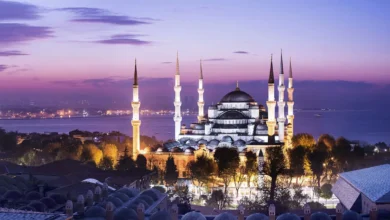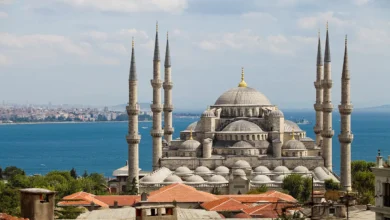
The Shesh Badgir Water Reservoir, a stunning piece of historical architecture in Yazd, Iran, dates back to the Qajar era. Renowned for its six iconic wind towers (Badgirs), this reservoir exemplifies ancient Persian engineering techniques used to cool and store water in the arid desert climate.
This architectural masterpiece reflects the ingenuity of Iranian civilization in overcoming the challenges of desert living. Beyond its functional purpose, the Shesh Badgir Water Reservoir stands as a symbol of cultural resilience and a testament to traditional innovation in Persian history.
History of the Shesh Badgir Water Reservoir
The Shesh Badgir Water Reservoir, constructed in 1834 AD (1218 AH) by Haj Mohammad Ibrahim Khormabadi, is an architectural marvel of the Qajar era. Located in the historic city of Yazd, its design incorporates six octagonal wind towers (Badgirs), demonstrating a blend of functionality and aesthetic excellence. These towers are a testament to the ingenuity of Persian architecture, providing natural cooling in the harsh desert climate.

Role in the Community
With a storage capacity of approximately 2,000 cubic meters, the reservoir was a critical source of drinking water for the residents of the Fahaadan neighborhood. The wind towers ensured the water remained cool and fresh, even during the intense heat of summer. The reservoir was not just a functional utility but also a hub of social and cultural interactions, deeply embedded in the daily lives of the local community.
Preservation and Renovation
Over the years, the Shesh Badgir Water Reservoir has undergone significant preservation efforts. In 1979, it was listed as a national heritage site of Iran under registration number 1600. Restoration projects have helped maintain its structural integrity and historical significance, making it a must-visit destination for tourists and history enthusiasts alike.
Architectural Features of the Shesh Badgir Water Reservoir
The Shesh Badgir Water Reservoir is renowned for its six majestic wind towers, each standing approximately 10 meters tall. These towers exemplify ancient Persian architectural ingenuity, designed to capture and channel desert breezes into the reservoir. By directing cool air downward, the Badgirs effectively reduced the temperature of the stored water, providing a sustainable cooling solution in the arid desert climate.
Imposing Dome and Robust Structure
A striking feature of the reservoir is its central dome, which measures 15 meters in diameter and rises 10 meters high. Constructed with brick and clay, the dome serves dual purposes: structural reinforcement and protection of the water from direct sunlight, thus minimizing evaporation. Its design harmonizes functionality with aesthetic appeal, reflecting the architectural mastery of the Qajar era.
Ingenious Interior Design
The reservoir’s interior features a deep, cylindrical chamber for water storage, engineered to preserve water quality in challenging environmental conditions. The ventilation system, powered by the six wind towers, ensured that the water remained cool and fresh throughout the year. This thoughtful design highlights the resourcefulness of Persian engineers in addressing the challenges of desert life.
Entrances and Dome of the Shesh Badgir Water Reservoir
The Shesh Badgir Water Reservoir in Yazd features two entrances—one to the north and one to the south—each with its own staircase and water outlet (Pashir). It is believed that the southern entrance was for Muslims, while the northern entrance, directly opposite the southern one, was used by Zoroastrians. However, some sources dispute this theory, suggesting that the entrances were designed to accommodate the large population and urban setting of the neighborhood rather than religious divisions.
Between steps 25 and 26 at the southern entrance, there is a small vestibule (Hashti) with brick flooring, leading into the reservoir’s vaulted space.
Interestingly, the staircase of the water reservoir is divided into two sections: one open-air, consisting of 55 steps leading to the entrance of the reservoir, and the second covered section, which begins after the entrance and continues to the roof.
The dome of the reservoir has an egg-shaped structure, adding a unique beauty to its architecture. The height of the water storage tank is 12.6 meters, while the wind towers (Badgirs) reach a height of 10 meters, further enhancing the structure’s aesthetic and functional appeal.
Components of the Shesh Badgir Water Reservoir
Traditional Persian water reservoirs typically consisted of four key components: the storage tank (Khazineh), dome, water outlet (Pashir), and wind towers (Badgirs). Each of these elements played a crucial role in preserving and maintaining the water. The Shesh Badgir Water Reservoir incorporates all of these features, highlighting the advanced engineering of its time.
- Storage Tank (Khazineh): The tank was dug deep into the earth to take advantage of the coolness of the ground, ensuring the water remained fresh and cool, even in the desert heat.
- Dome: Constructed as a hemispherical structure above the tank, the dome served to protect the water from contamination and to reduce evaporation, keeping the water clean and preserved.
- Water Outlet (Pashir): A stairway corridor was designed to access the stored water. This feature made it easier to retrieve water while minimizing exposure to the environment.
- Wind Towers (Badgirs): These iconic structures were specifically built to direct cool air into the storage tank, ensuring the water was kept cool even during the hot summer months.
The combination of these four components demonstrates the ingenuity of Persian architecture in overcoming the challenges posed by water storage in the arid desert climate.
Water Storage and Conservation Techniques
Water Storage and Conservation Techniques at the Shesh Badgir Water Reservoir

Impressive Water Storage Capacity
The Shesh Badgir Water Reservoir boasts a storage capacity of approximately 2,000 cubic meters, making it one of the largest and most vital water reservoirs in Yazd. This significant capacity ensured a consistent water supply for the local population, particularly during periods of drought and the scorching summer months. Its efficient design highlights the resourcefulness of Persian engineering in addressing the water scarcity challenges of desert regions.
Innovative Water Supply System
The reservoir was ingeniously connected to the ancient Zarch Qanat, one of the oldest and longest qanat systems in the world. This underground channel network transported fresh water from distant aquifers to the reservoir, ensuring a steady and sustainable supply of water. The qanat system’s reliance on gravity and underground construction minimized water loss due to evaporation, making it a lifeline for the residents of Yazd in an arid climate.
Sustainability Through Conservation
The combination of large storage capacity and an efficient supply system reflects a deep understanding of water conservation techniques in ancient Persia. By leveraging the natural cooling effects of the wind towers and the steady flow of the qanat, the Shesh Badgir Water Reservoir exemplifies how traditional engineering addressed environmental challenges with innovative solutions.
The Builder of the Shesh Badgir Water Reservoir
A Unique Adobe Structure with Six Wind Towers and a Dome
The Shesh Badgir Water Reservoir, one of the most beautiful and iconic reservoirs in Yazd, was built through the philanthropic efforts of Haj Mohammad Hossein Kheir, the son of Noorollah Yazdi. This architectural masterpiece is the only six-wind-tower water reservoir in Iran.
According to the endowment document, Haj Mohammad Hossein financed the construction of the reservoir using his properties and assets in Yazd and Taft. After its completion, a man named Beheshtian ensured the reservoir remained filled with water sourced from the Vakfabad stream, one of Yazd’s main water channels.
Visiting Tips for the Shesh Badgir Water Reservoir
Best Time to Visit
The ideal time to visit the Shesh Badgir Water Reservoir is during the cooler months, from late autumn to early spring. Yazd’s hot summers can make outdoor activities uncomfortable, so visiting in spring or fall will provide a more pleasant experience.
How to Get There
Located in the heart of Yazd’s historical district, the Shesh Badgir Water Reservoir is easily accessible by car or on foot. It’s recommended to walk through the old town to fully appreciate the architectural beauty of the area.
Photography Tips
Don’t forget your camera! The Shesh Badgir Water Reservoir offers plenty of photographic opportunities, especially the wind towers, dome, and intricate brickwork. The best time for photos is early morning or late afternoon when the light is softer.
Nearby Attractions
While in the area, make sure to visit other nearby attractions in Yazd, such as the Jameh Mosque, Dowlat Abad Garden, and the Towers of Silence.





